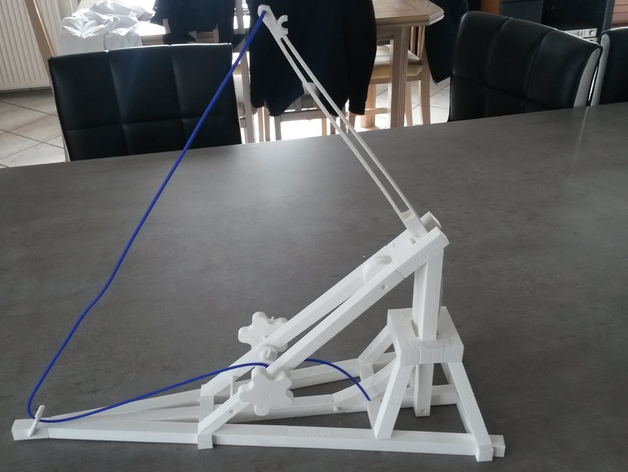
Leonardo Da Vinci Catapult
thingiverse
This catapult was my entry for the "Da Vinci Gear Challenge" organized by the company "Stratasys". Post-processing: some pieces don't need support for print, others do. No tools or glue needed because of the carpentry joints. I have chosen this Catapult, because I did exactly the same a few months ago, but it was not 3D printable at that time. So I changed everything. (see it on my GrabCAD account: https://grabcad.com/library/leonardo-da-vinci-catapult-1https://grabcad.com/library/leonardo-davinci-s-catapult-1) First I scaled it down to 7 meters to 500mm. But I've tried to keep the proportion and make it sturdy. Then all the joints were made so that the whole structure is sturdy. I asked my father for some carpentry joints. Naturally I have let some tolerances for the joints, for that I used the equation system in SolidWorks, so that it is easily changeable. Now the tolerance is 0.4mm. Is it Printable? I've printed the whole Catapult with my 3D Printer. For that, I used M-ABS, I bought some recently. And I was impressed how sturdy it is! -So all parts can be easily printed with an FDM printer. So in conclusion: the catapult works perfectly! It shoots the small 3D printed balls 9 foot away or 3 meters (which is quite impressive, I think!). Print Settings Printer Brand: Ultimaker Printer: Ultimaker 2 Rafts: No Supports: Yes Resolution: 0.2mm Infill: 20% Notes: I've printed the model with a 0.2mm layer height (to print it very fast) and I've just done an infill of 20%, but it will bend a little with 20%, so print it with 50% infill. Post-Printing 0.2mm Layer height & 20% Infill How I Designed This Designing A few months ago, I did the same catapult but in a one solid block, now I've cut the whole thing into manageable 3D printable pieces. So I've got more than 30 pieces for the catapult. And because my father is a carpenter, I asked him how to make some joints: especially the joint for the arm, it's a sort of scarf joint that is really sturdy for this application. After designing all pieces, I had to improve the flexibility of the arm, so I did 6 different versions of it, and the last one works really great (see the video). Custom Section Leonardo DaVinci Catapult This project was made on my favorite 3D design software: SolidWorks. I've been using it for 4 years now, and I'm still amazed that almost every day I'm learning something new. And after printing this whole thing, I learned how ABS reacts to stress, and flexion! It wasn't that difficult to print, because I used "BigPrint", but be careful with isometric view! Then after more than 20 hours of work, you'll get a 3D printable Catapult (That will work of course!). First: You'll need a good 3D designing software, I used SolidWorks, I took the original picture of the catapult, and then calculated with "BigPrint" the dimensions. Second: you will need a printer that has a print volume of ~200 x 200 x 200 mm, so that you are able to print the big pieces (in diagonal). Designing with students is quite a long process, I think 2 months will be nothing for this catapult! And the printing is also gonna take some time, so... I guess half of a school year? HAVE SOME EXPERIENCE WITH SOLIDWORKS! Seriously SolidWorks, is a great tool, you have to know how it works, it has to be your friend! Don't see SolidWorks as something bad. It's great! And of course some experience with 3D printing. You'll need only 2 things: a picture of the whole catapult (Yes one is sufficient, trust me, I did it, so you can!) and you'll need to make some research on Wooden joints/Carpenterie, those joints are the most robust out there! At the end of the project, you'll get a Leonardo DaVinci catapult (scaled down of course) that is working, so have fun with it, do some scaled-down medieval wars! -For the whole project you'll need: BigPrint, SolidWorks, a 3D Printer, and the original Leonardo DaVinci Catapult.
With this file you will be able to print Leonardo Da Vinci Catapult with your 3D printer. Click on the button and save the file on your computer to work, edit or customize your design. You can also find more 3D designs for printers on Leonardo Da Vinci Catapult.
